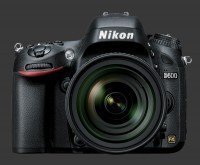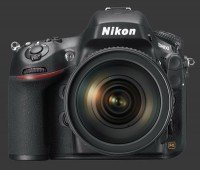Nikon D800 Review
Nikon D800 Usability - How easy is it to use?
While every DSLR is different and Nikon refines its models over time, the Nikon D800 is incredibly simple with very intuitive controls. The great thing is that its advanced features adds very little complexity to the camera and one learns his way around this DSLR in no time. The number of well-labelled external controls make it efficient and greatly reduces the need to look through the menu system.
Ergonomics of the Nikon D800 are generally quite good. The camera feels very solid and on the heavy side which gives it added stability. The hand grip is quite straight with a small protrusion and widening at the top where the front-control-dial is mounted. The protrusion helps support the camera while rubber coating around the grip provides good traction.
The shutter-release is mounted at the top of the grip with a slight angle. This is a two-stage release with short travel and a very soft halfway point. This makes it easy to shoot without jolting the whole camera down and just as easy to take one accidentally. The front control-dial is within easy reach of the index finger from the shutter-release.
The top of the grip has the power-switch around the shutter-release and three buttons behind it. The EC button finds itself on the outer edge of the camera body. While it is within reach of the index finder, it is not comfortable to do so. Given that EC is very commonly used, it would have been much better to move it to where the the Video Record button is. That button starts and stops video capture and does nothing outside of Video mode. Behind it is the Mode button.


The top plate of the D800 has four buttons stacked over the drive-mode dial which is now tall enough to operate with gloves on. Press the lock button in front of the dial and turn to change drive-modes. The four buttons, used in conjunction with the control-dials, as detailed further down, control: Image Quality, Bracketing, ISO and WB.
The rear of this DSLR is very ergonomic. There is a large 3.2" LCD with 920K pixels aligned with the optical viewfinder. The LCD is sharp with a wide viewing-angle and good refresh rate. Visibility is good and the anti-reflective coating works well. Despite the new gel layer, the LCD fogs up easily, and so does the OVF. Next to the OVF, a small switch controls a built-in viewfinder shutter. Use it to prevent light from entering through the viewfinder during long exposures.

Towards the left of the LCD and OVF are 7 buttons, mostly arranged in a column. It is really great that there is such space to the left of the LCD. A number of modern DSLRs have the LCD flush with the edge of the camera which frequently causes the display to get smudged. As anyone using sunscreen quickly discovers, it is very hard to clean it off in the field. Nikon also generously includes a protective plastic LCD cover with the D800.
The top two buttons, Play and Delete, are easy to reach and work well together. Pressing Delete once prompts to delete the shown image. Pressing it again confirms and pressing Play cancels. This makes deleting each image from a single card efficient. Deleting an image from both cards is problematic though. Since Playback mode shows images from one card followed by images the other, one must navigate to the end of the card to delete its duplicate. Pretty soon, one gives up doing this and space gets eaten by all those images that should have been deleted. This happens because the D800 only uses the least amount of space available on either card when Slot 2 is set to Backup. If Nikon could provide a firmware update to add the option of deleting both copies together, it would be truly welcome!
The column below those has 5 buttons: Menu, Picture Style, Zoom In, Zoom Out and OK. These buttons all do the obvious and their placement is reasonable. The OK button is almost redundant with the central button of the 8-way controller. In some cases, for more critical operations such as formatting a card, OK must be pressed.
The D800 features dual control-dials which are easy to reach without shifting your grip. These dials have plenty of customization options affecting how they work. This includes options to reverse them, switch them and even flip visual indicators.
Both controls dials are put to good use. Enabling Easy ISO in the configuration menu under ISO Display and Adjustment lets the otherwise-unused dial control ISO sensitivity. A similar option called Easy EC exists which makes the same dial apply exposure-compensation without having to hold-down the EC button. With Easy ISO enabled, which we highly recommend, the dials work as follows:
| Mode/ Button | Front Dial | Rear Dial |
|---|---|---|
| P | ISO | Program Shift |
| S | ISO | Shutter-Speed |
| A | Aperture | ISO |
| M | Aperture | Shutter-Speed |
| EC | EC | |
| Mode | Mode | |
| Bracketing | Increments | Frames |
| Flash | FC | Flash Mode |
| WB | B-A Tuning | WB |
| ISO | Auto Toggle | ISO |
Towards the right of the OVF and rear LCD are a few controls. The AE-L / AF-L and AF-On button have obvious defaults but either can be configured from the same set of 17 functions mentioned on the previous page of this review. Around AE-L / AF-L is a three-way rotating switch to choose between metering patterns. There are in fact four metering patterns on all high-end Nikon DSLRs with Average replacing Center-Weighed when chosen in the Custom Settings menu.
To the right of AF-On is the rear control-dial which Nikon considers the main one. An inch below, there is an 8-way controller with central OK button and rotating lock switch. In capture mode, the controller is used to move around the focus point or area, unless the outer switch is set to the Lock (L) position. This controller is also used to navigate the menu system and interactive status display.

Directly below the 8-way controller is the Live-View button surrounded by a rotating switch. The button toggles Live-View, while the switch chooses between Still and Video mode. Video mode shows the right aspect-ratio for video and enables the Video Record button on top of the hand-grip. It also restricts shutter-speeds to less than the video frame-rate.
The last button to the right of the LCD is Info. This one cycles through various display modes in Live-View and shows or enters the interactive status display in viewfinder mode. There are 10 editable options: Shooting Bank Menu, High ISO Noise-Reduction, Active D-Lighting, Color-Space, Preview Button, Custom Settings Bank, Long Exposure Noise-Reduction, Bracketing Button, AE-L /AF-L Button and Function Button. These are all short-cuts to different menu items.
The optical viewfinder is very large and bright with 100% coverage. The viewfinder features an optional DX crop framing guide and an optional composition grid. Both axis of the digital-level can be shown in the viewfinder as tilt and pitch indicators superimposed on the image area. Unfortunately, the black color of the indicators make them hard to see over dark areas of the frame.
The status line shows Metering, Shutter-Speed, Aperture, Exposure-Mode, EC, ISO and the number of frames remaining. It also has a great MF direction indicator that shows in which direction the lens needs to be focused. Plus, it confirms when focus has been established at the center of the frame.
While some constructive criticism regarding ergonomics were discussed above, Live-View is problematic, only a little less than the newer Nikon D600
Nikon D600. Many photographers could not care less but video depends on it. Live-View is far from perfect:
- Exposure-Priority: This DSLR thankfully shows an Exposure-Priority display in Manual mode and even the optional Live-Histogram follows. This is a first among Nikon cameras. However, it does not do the same in Program and Aperture-Priority mode, when the preview is slightly off. In Shutter-Priority, the preview is often completely wrong and changing parameters that brighten the results can show a darker preview!
- Depth-Of-Field: This digital camera stops down the lens aperture immediately in Live-View and therefore the depth-of-field is always previewed.
- White-Balance: The camera applies different WB settings to the Live-View preview than to images. One can change the captured WB without seeing any change on the display while one can change the display white-balance without any effect on images! This is certainly one of the most baffling behaviors ever seen.
- Inconsistent Metering: The metering system used in Live-View differs from the one normally used.

There are a unusually high number of controls on the front of the camera. On the left side of the flash housing is a mechanical flash-release button. Below it there is a Flash button. When used in conjunction with control-dials, it can changes the flash mode and flash compensation. Further down is a typical lens release button.
Near the base of the lens mount is the focus controller which configures the highly versatile 51-point autofocus system of the D800. The outer part of the switch rotates between AF and MF mode. At M, AF is disengaged and no further AF functions apply. At the AF position, the central button enables the front control-dial to set the focus-point selection mode and the rear one to set the focus-drive mode.
There are two focus-drive modes, AF-S which is single-shot autofocus, AF-C which is continuous autofocus. In Live-View, AF-C appears as AF-F since the behavior is somewhat different. There are six focus-point selection modes with only the first two available in AF-S:
- Auto: The camera automatically selects among its 51 AF points and highlights all those in focus.
- Single-Point: The user selects a single point among all 51 using the 8-way controller on the back of the camera. Pressing the central button resets focus to the center point.
- 9-Point Dynamic Area: The user selects one point among all 51 and the camera tries to keep the subject in focus at one of the 9 closest points.
- 21-Point Dynamic Area: The same thing except that the camera tries to keep the subject in focus at one of the 21 closest points. There is greater risk of focusing on the wrong subject while allowing to follow faster movement.
- 51-Point Dynamic Area: Again the user chooses a single point but the camera looks at all 51 points to focus on the subject. The camera can more easily focus on the wrong subject but it can handle erratic motion.
- 3D Predictive Tracking: The camera locks onto the subject under the selected focus-point and follows it around the frame.
The last two buttons on the front are unmarked. The top one is the DOF-Preview button due to its default setting and the bottom one is simply called Function button. Each button can be unassigned are take on any one of 22 functions: DOF Preview, FV Lock, AE/AF-L, AE-L, AE-L Hold, AF-L, AF-On, Flash Off, Bracket Burst, ADL, RAW, Matrix Metering, Center-Weighed Metering, Spot Metering, Framing Grid, FX/DX Image Area, Virtual Horizon, My Menu, My Menu Top-Item, 1 EV Step, Non-CPU lens or Playback.
Customizing one of these buttons is the only way to access DOF Preview or the digital level in the viewfinder, so these are the most common assignments.

Like all DSLRs, the Nikon D800 includes a metal tripod-mount aligned with the center of the lens. The battery-compartment is weather-sealed and has a small latch to prevent the battery from falling. The battery used in the D800 gives detailed information about its status. An item in the Setup menu shows the current charge and its age on a relative 5-step scale.
The Nikon D800 handles rather well outside of Live-View. Playback mode shows a short-but-noticeable lag to switch frames. The rear control-dial switches frames even when zoomed-in, which is nice to compare shots for focus and fine details.
The main usability complaints are a hidden Exposure Delay Mode and difficult-to-see digital-level in the OVF. At least the Exposure Delay Mode can be chosen as the first item in My Menu and then one of the front buttons can jump to it directly. Things would be further improved if images could be deleted simultaneously from both cards. Serious low-light photographers should get around the delay problem entirely by acquiring a compatible remote shutter-release for the D800.
 |
Please Support Neocamera
All information on Neocamera is provided free of charge yet running this website is a huge endeavor. Purchases made via affiliate links found throughout the site help keep it running and up-to-date. There is no additional cost to you, so please consider buying via these links to our affilates:
If you found any information on this site valuable and did not purchase via our affiliate links, please considering donating via PayPal:
Any amount will be greatly appreaciated. Thank you for your support!
Nikon D800 Highlights

Sensor-Size: 36 x 24mm

Actual size when viewed at 100 DPI
| 36 Megapixels DSLR | ISO 50-25600 |
| Nikon F Mount 1X FLM | Shutter 1/8000-30s |
| 100% Coverage Extra Large Viewfinder | Full manual controls, including Manual Focus |
| 2 Axis Digital Level | Custom white-balance with 2 axis fine-tuning |
| Weatherproof | Spot-Metering |
| Built-in Dust Reduction | Hot-Shoe & Sync-Port |
| 4 FPS Drive, 22 Images | Stereo audio input |
| 1920x1080 @ 30 FPS Video Recording | Lithium-Ion Battery |
| 3.2" LCD 920K Pixels | Secure Digital Extended Capacity, Compact Flash Type 1 |
Updates
2025.01.18

Fujifilm GFX 2025 Lens Roundup
Lens Review roundup of Fujifilm GFX Medium-Format lenses. Quality, performance and handling of the GF20-35mm F/4R WR, GF30mm F/3.5 Tilt-Shift and the GF55mm F/1.7.
2024.11.18

Best 2024 Photography Gifts for Every Budget
Great gifts for photographers and photo enthusiasts selected for every budget among the best products of 2024.
2024.08.07

Eye Protection Tips for Professional Photographers
The four main considerations for professional photographers regarding eyewear.
2024.07.14

Fujifilm X100VI Review
Flagship fixed-lens compact digital camera with a 40 MP sensor and Image-Stabilization, a first for the series. Retro design featuring dual control-dials, plus direct ISO, Shutter-Speed and EC dials. Its hybrid viewfinder can switch between EVF and OVF mode.
2024.05.09

Fujifilm GFX100 II Review
Flagship 102 Megapixels Medium-Format Mirrorless Digital Camera with 8-Stop 5-Axis IBIS, 8 FPS Drive, 8K Video and 400 MP Super-Resolution capture in a weatherproof and freezeproof body with dual control-dials and dual memory-card slots.
2024.04.03

Fujifilm X-T5 Review
Newest Fujifilm flagship boasting a 40 MP APS-C sensor, 5-axis IBIS with 7-stop efficiency, 15 FPS continuous drive, 6.2K Video capture, dual control-dials and dual SDXC UHS-II slots in a sturdy weatherproof and freezeproof body.
2023.11.20

Best Digital Cameras of 2023
Find out which are the Best Digital Cameras of 2023. All the new Mirrorless Digital Cameras from entry-level to high-end professional.
2023.07.10

Fujifilm X-H2 Review
40 Megapixels APS-C Hybrid Mirrorless Digital Camera with 7-stop IBIS. Fastest shutter ever and 8K video capture. Large builtin EVF with 0.8X magnification and 5.8 MP, plus an Eye-Start Sensor. Packed with features and large number of controls in a weatherproof and freezeproof body.
2023.05.07

Sony FE 20-70mm F/4G Review
Review of the unique Sony FE 20-70mm F/4G lens. The optical zoom of this lens spans ultra-wide-angle and medium focal-length coverage, making it one of the most versatile Full-Frame lenses on the market.
2023.01.15

Huion Inspiroy Dial 2 Review
Review of the Huion Inspiroy Dial 2 tablet, a medium sized drawing surface with dual dials and customizable buttons. Connects via USB-C or Bluetooth 5.0 with Windows, Linux and Android support.
2022.12.08

How to Pack for a Photo Trip
Find out how to pack for a travel photography trip, carry your gear safely while meeting airline regulations.
2022.11.13

Best Digital Cameras of 2022
The best digital cameras of 2022. A short list of the most outstanding models in their respective categories. Choose one for yourself or as a gift.













